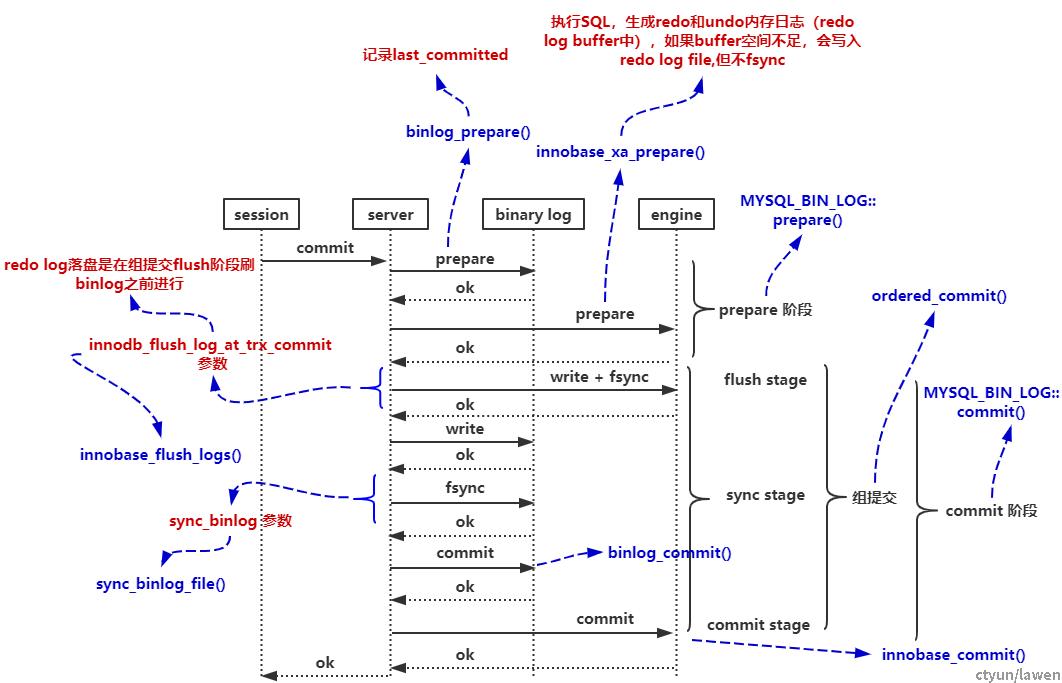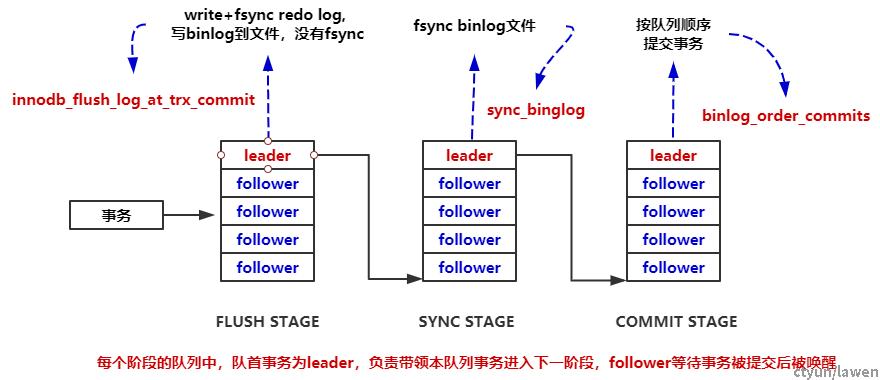MySQL 二阶段提交及组提交分析
以下基于MySQL 5.7.21 源码分析
1. 完整二阶段提交和组提交时序图

sync_binlog=0, fsync()的调用完全交给操作系统,即文件系统缓存中的binlog是否刷新到disk完全由操作系统控制 。
sync_binlog=1,每次事务提交都会调用 fsync(),最大限度保证数据安全。
sync_binlog=N,积累一定数量的binlog一起fsync,当数据库崩溃时,可能会丢失 N-1 个事务。
innodb_flush_log_at_trx_commit=0 : redo log buffer的内容每秒会被写入文件系统缓存的redo log里,同时被fsync到disk上的redo log file中。
innodb_flush_log_at_trx_commit=1 : redo log buffer的内容会在事务commit时被写入文件系统缓存的redo log里,同时被fsync到disk上的redo log file中。
innodb_flush_log_at_trx_commit=2 : redo log buffer的内容会在事务commit时被写入文件系统缓存的redo log里,而文件系统缓存的redo log每秒一次被fsync到disk上的redo log file中。
2. 二阶段提交
2.1 二阶段提交的背景
Since MySQL supports PSEA (pluggable storage engine architecture), more than one transactional engine can be active at a time. Hence transactions, from the server point of view, are always distributed. In particular, transactional state is maintained independently for each engine. In order to commit a transaction the two phase commit protocol is employed.
另外,通过二阶段提交,解决了binlog写入顺序和redo log写入顺序的一致性问题。因为binlog是master-salve的桥梁,如果不一致,则在数据库崩溃恢复后,主从数据可能不一致。
2.2 二阶段提交实现的基本流程
binlog既是二阶段的参与者,又是协调者,所以在源码实现中可以看到 prepare阶段 和 commit阶段函数入口都在MYSQL_BIN_LOG中。
ha_commit_trans() # 事务提交入口
|
|- MYSQL_BIN_LOG::prepare() # 进入prepare阶段
| |- ha_prepare_low()
| | |- binlog_prepare() # 记录last_committed
| | |- innobase_xa_prepare() # 执行SQL,生成redo log和undo log内存日志(log buffer)
|
|- MYSQL_BIN_LOG::commit() # 进入commit阶段
| |- Trans_delegate::before_commit() # run hook
| |- ordered_commit() # 进入组提交
| | |- FLUSH_STAGE # flush 阶段,write+fsync redo log, 写binlog文件
| | |- SYNC_STAGE # sync 阶段,fsync binlog文件到磁盘
| | |- COMMIT_STAGE # commit阶段,事务按队列顺序提交
| | | ...
| | |- finish_commit()
innodb prepare阶段并没有写redo log到文件中,除非redo log buffer空间不足。以下可看出:
innobase_xa_prepare() # innodb prepapre
| ...
|- trx_prepare_for_mysql()
| |- trx_prepare()
| | |- trx_prepare_low()
| | | |- mtr_t::start() # 开启一个mini-transaction
| | | |- mtr_t::commit() # 通过mtr,写redo到redo log buffer
| | | | |- Command::execute()
| | | | | |- prepare_write() # 准备写mtr log到redo-log buffer
| | | | | |- finish_write()
| | |- trx->state = TRX_STATE_PREPARED
finish_write()
| ...
|- log_reserve_and_open()
| |- # not enough space,do a write of buffer
| |- log_buffer_sync_in_background(false) # not enough space,do a write of buffer
| | |- log_write_up_to(lsn, false) # write to redo log file,没有执行fsync
| | | |- log_group_write_buf() # Writes a buffer to a log file group
|...
|- mtr_write_log_t::operator() # append blocks to redo log buffer
| |- log_write_low() # 写 redo log block 到 redo log buffer
从上面过程可以看出,prepare阶段并没有写redo log到文件中,只有一种情况会写入到文件中,那就是redo log buffer空间不足时,并且这里只是写入文件系统缓存,并不执行flush操作。
3. 组提交
3.1 组提交的目的及意义
解决写日志时频繁刷盘的问题。组提交包括binlog和redo log的组提交。
3.2 binlog组提交实现
binlog组提交的基本思想是,引入队列机制保证innodb commit顺序与binlog落盘顺序一致,并将事务分组,组内的binlog刷盘动作交给一个事务进行,实现组提交。

ordered_commit() 中涉及到的几个参数:
- innodb_flush_log_at_trx_commit # (重要)决定redo log刷盘
- sync_binglog # (重要)决定bin log刷盘
- binlog_group_commit_sync_delay # 延迟多久后开始binlog刷盘
- binlog_group_commit_sync_no_delay_count # 在中止当前延迟之前等待的最大事务数
- binlog_order_commits # 决定是否按照binlog顺序提交
ordered_commit()
|...
| |- change_stage(FLUSH_STAGE) # 进入FLUSH_STAGE,将当前事务加入到m_queue[FLUSH_STAGE]中,如果队列为空,则自动为leader,对LOCK_log加锁,返回false,否则队列不为空为follower,follower 会一直阻塞,直到事务提交后被唤醒,返回true,follower直接进入finish_commit()。
| |...
| |- process_flush_stage_queue()
| | |- ha_flush_logs(true) # 根据innodb_flush_log_at_trx_commit配置决定是否write+fsync redo log到磁盘
| | |- assign_automatic_gtids_to_flush_group() # 给flush队列里面的事务分配gtid
| | |- flush_thread_caches() # 写binlog到I/O cache中,先写gtid再写其他事件
| |...
| |- flush_cache_to_file() # 实际写入binary log文件,没有fsync
| |- RUN_HOOK(binlog_storage, after_flush)
| |...
| | - change_stage(SYNC_STAGE) # 进入 sync 阶段,将当前事务加入到m_queue[SYNC_STAGE]中,队列为空,该线程成为leader,对LOCK_sync加锁,释放LOCK_log锁,返回false;否则队列不为空,成为follower,返回true,follower直接进入finish_commit
| |...
| |- sync_binlog_file(false) # 根据 sync_binlog 配置,决定是否执行fsync
| |...
| |- 开启了 binlog_order_commits配置,会继续下面的COMMIT_STAGE,否则直接进入finish_commit
| |...
| |- change_stage(COMMIT_STAGE) # 进入 commit 阶段,当前事务加入到m_queue[COMMIT_STAGE]中,队列为空,自动成为leader,对 LOCK_commit 加锁,释放LOCK_sync锁,返回false;否则队列不空,成为follower,返回true,follower直接进入 finish_commit()
| |- RUN_HOOK(binlog_storage, after_sync)
| |- process_commit_stage_queue() # 按commit_queue队列顺序执行ha_commit_low
| | |- ha_commit_low()
| | | |- binlog_commit() # binlog 提交
| | | |- innobase_commit() # innodb 提交
| |- process_after_commit_stage_queue()
| | |- RUN_HOOK(transaction, after_commit) # 按commit_queue队列顺序RUN_HOOK
| |...
| |- stage_manager.signal_done(final_queue) # 事务提交完成,通知所有等待的follower事务
| |- finish_commit()
ha_flush_logs(true)
|- flush_handlerton(true)
| |- innobase_flush_logs(true)
| | |- if innodb_flush_log_at_trx_commit=0,return
| | |- log_buffer_flush_to_disk(flush_log_at_trx_commit == 1)
| | | |- log_write_up_to(flush_log_at_trx_commit == 1)
| | | | |- log_group_write_buf() # 写到redo log file
| | | | |- log_write_flush_to_disk_low() # fsync redo log file 到磁盘
3.3 redo log 组提交实现
-
将多个事务redo log的刷盘动作合并,减少磁盘顺序写 (redo log是顺序写)。
-
每个redo log都有一个LSN(Log Sequence Number),LSN是单调递增。
-
每个事务执行更新操作都会包含一条或多条redo log,各个事务将日志拷贝到log_sys_buffer时(log_sys_buffer 通过log_mutex保护),都会获取当前最大的LSN,因此可以保证不同事务的LSN不会重复。
-
那么假设三个事务Trx1,Trx2和Trx3的日志的最大LSN分别为LSN1,LSN2,LSN3(LSN1<LSN2<LSN3),它们同时进行提交,那么如果Trx3日志先获取到log_mutex进行落盘,它就可以顺便把[LSN1---LSN3]这段日志也刷了,这样Trx1和Trx2就不用再次请求磁盘IO。
-
通过上面的order_commit(),我们知道,刷redo log动作是在flush阶段、刷binlog之前,这个优化是在mysql 5.7.6引入,(之前是在prepare阶段刷redo log),该优化做到了:
-
一方面,保证了刷binlog之前一定会刷redo log,保证了原来的故障恢复的逻辑;
-
另一方面,可以不用每个事务都刷盘,而是leader事务帮助刷一批redo。
-
-
redo log组提交实现流程(log_write_up_to()):
-
1、获取 log_sys->write_mutex
-
2、若flushed_to_disk_lsn>=lsn,表示日志已经被刷盘,跳转8后,退出
-
3、若 current_flush_lsn>=lsn,表示日志正在刷盘中,跳转8后,进入等待状态
-
4、获取 log_sys->mutex
-
5、计算写入的起点、终点,记录write_lsn等
-
6、释放 log_sys->mutex
-
7、将小于LSN的日志 写入 文件 : log_group_write_buf()
-
8、释放 log_sys->write_mutex
-
9、fsync日志文件 : log_write_flush_to_disk_low()
-
备注:lsn表示事务的lsn( log_sys->lsn始终保持了当前最大的lsn ),flushed_to_disk_lsn和current_flush_lsn分别表示已刷盘的LSN和正在刷盘的LSN。
-